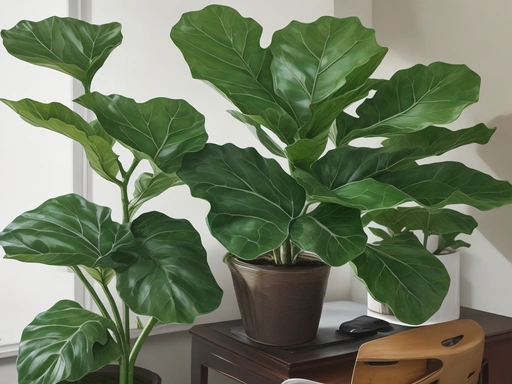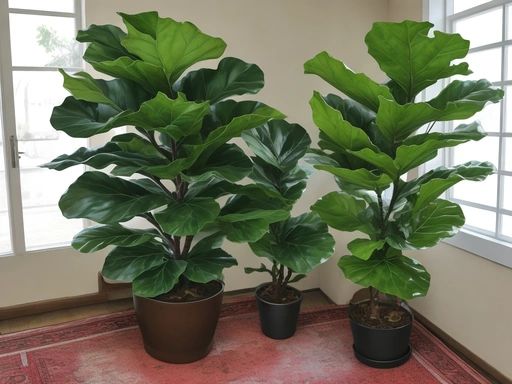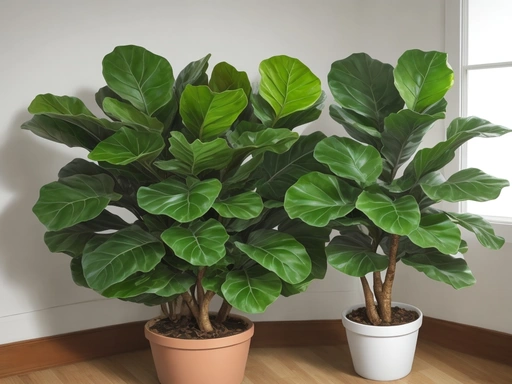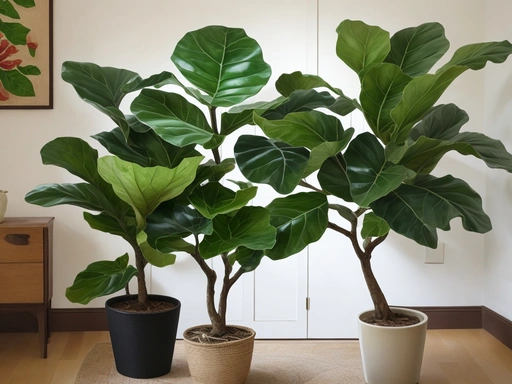Seasonal Care For Indoor Fiddle-Leaf Figs: A Guide to Thriving Greenery

Key Takeaways Seasonal Care For Indoor Fiddle-Leaf Figs:
- Proper watering is crucial: Avoid overwatering your indoor fiddle-leaf figs, which can lead to root rot.
- Provide adequate sunlight: Place your fiddle-leaf figs near a bright window or invest in artificial grow lights to ensure they receive enough light.
- Regular pruning helps maintain size and shape: Trim back any overgrown or damaged leaves to promote healthy growth.
- Monitor humidity levels: Fiddle-leaf figs thrive in moderately humid environments, so using a humidifier or placing a tray with water near the plant can help maintain optimal conditions.
Are you a proud plant parent of an indoor Fiddle-leaf fig?
Get ready to take your plant care skills to the next level with this ultimate guide to seasonal care for indoor Fiddle-leaf figs.
From spring to winter, I’ll walk you through the specific care tips and tricks for each season.
Learn how to adjust light and temperature, repot and fertilize, prevent pests, and more.
Worried about common issues?
Don’t fret; we have troubleshooting tips, too.
Get ready to give your Fiddle-leaf fig the royal treatment it deserves!
| Season | Care Tips |
|---|---|
| Spring | – Increase watering frequency – Start fertilizing with a balanced houseplant fertilizer – Prune to shape the plant |
| Summer | – Maintain consistent watering schedule – Place the plant in a bright location with indirect sunlight – Mist the leaves to increase humidity |
| Fall | – Reduce watering frequency as days get shorter – Decrease fertilization to prepare for winter dormancy – Monitor for pests and treat if necessary |
| Winter | – Water sparingly, allowing the soil to dry out between waterings – Place in a cooler location away from drafts and heating vents – Reduce misting as indoor humidity decreases |
Understanding Fiddle-leaf Fig Plants
Fiddle-leaf fig plants are popular indoor plants known for their large, glossy leaves.
They thrive in bright, indirect light and require regular watering.
Understanding their specific care needs is essential for keeping them healthy and thriving in your home.

Benefits of Indoor Fiddle-leaf Fig Plants
Indoor fiddle-leaf fig plants offer a range of benefits. They purify the air, creating a healthier indoor environment.
These plants also add a touch of natural beauty and can be a focal point in any room.
Additionally, they are relatively low-maintenance, making them perfect for busy individuals.

Seasonal Care for Indoor Fiddle-leaf Figs
Seasonal care for indoor Fiddle-leaf figs is essential for their health and growth.
Spring Care Tips for Indoor Fiddle-leaf Figs
It’s important to adjust the light and temperature during spring to provide optimal conditions for your indoor fiddle-leaf fig.
Repotting and fertilization can also be done during this time to promote healthy growth.
Preventing and controlling pests is crucial during this season to protect your plant.

Adjusting Light and Temperature
To adjust the light and temperature for your indoor Fiddle-leaf fig, place it in a bright spot with indirect sunlight. Avoid exposing it to direct sunlight, as it can scorch the leaves.
Keep the room temperature between 60-75°F (15-24°C) and avoid placing the plant near drafts or heaters.

Repotting and Fertilization
Repot your indoor Fiddle-leaf fig every 1-2 years using a well-draining potting mix. Choose a pot that is slightly larger than the current one.
Fertilize during the growing season (spring and summer) with a balanced houseplant fertilizer.
Dilute it to half-strength and apply monthly. Avoid over-fertilization to prevent burn and leaf damage.
Pest Prevention and Control
To prevent pests from infesting your indoor Fiddle-leaf fig, regularly inspect the plant for signs of insects or diseases.
Keep the plant clean by wiping the leaves with a damp cloth to remove dust and debris.
Provide proper airflow and avoid overwatering to discourage pest infestation.
If you notice any pests, such as spider mites or mealybugs, gently wipe them off with a cotton swab dipped in rubbing alcohol.
Summer Care Tips for Indoor Fiddle-leaf Figs
During the summer, it’s important to provide proper care for your indoor fiddle-leaf fig. Here are some tips:
- Watering and humidity: Increase watering frequency to keep the soil consistently moist, but not overly wet. Mist the leaves regularly to increase humidity levels.
- Pruning and training: Trim any leggy or damaged branches to maintain a compact and bushy shape. Use stakes or ties to support the plant and encourage upright growth.
- Protect from direct sunlight: Fiddle-leaf figs prefer bright, indirect light. Shield them from direct sunlight, as it can cause leaf burn. Place them near a window with filtered light.
Remember, each plant is unique, so be sure to observe its specific needs and adjust your care accordingly.
Watering and Humidity
Watering and humidity are important factors to consider when caring for indoor fiddle-leaf figs. It’s best to water your plant when the top inch of soil feels dry.
Avoid overwatering, as it can lead to root rot.
Fiddle-leaf figs prefer a humid environment, so misting the leaves or using a humidifier can help maintain the right moisture levels.
Pruning and Training
Pruning and training are important aspects of caring for indoor Fiddle-leaf fig plants.
Regular pruning helps maintain the shape and size of the plant, encourages new growth, and removes any dead or diseased leaves.
It is best to prune during the spring or summer months.
Training involves using stakes or a moss pole to support the plant’s growth and encourage it to grow upright.
This helps prevent the plant from becoming leggy and ensures that it develops a strong and attractive structure.
Pruning and training are simple yet effective techniques to keep your Fiddle-leaf fig healthy and looking its best.
Protecting from Direct Sunlight
To protect your indoor Fiddle-leaf fig from direct sunlight, it’s important to find a bright location with filtered or indirect light.
Avoid placing it in direct sunlight as it can scorch the leaves.
You can use curtains or blinds to filter the light or move the plant to a spot where it receives bright, indirect light.
Autumn Care Tips for Indoor Fiddle-leaf Figs
During autumn, indoor fiddle-leaf figs need some adjustments to thrive. Here are the key care tips:
- Adjust light and temperature: Move your plant away from drafty windows and ensure it receives bright, indirect light.
- Reduce watering: As the plant’s growth slows down, decrease watering frequency to prevent overwatering and root rot.
- Clean and dust leaves: Regularly wipe the dust off your fig’s leaves with a damp cloth to keep them clean and allow for better photosynthesis.
Adjusting Light and Temperature
To adjust light and temperature for your indoor fiddle-leaf fig, place it in bright, indirect light.
Avoid direct sunlight, as it can scorch the leaves.
As for temperature, keep it between 60-75°F (15-24°C) during the day and slightly cooler at night.
Remember to rotate the plant every once in a while to ensure even light exposure.
Reducing Watering Frequency
To reduce watering frequency for your indoor fiddle-leaf fig, make sure to allow the top inch of soil to dry out between waterings.
Avoid overwatering, as this can lead to root rot.
Additionally, adjust your watering schedule based on the season to account for changing moisture needs.
Cleaning and Dusting Leaves
To clean and dust the leaves of your indoor Fiddle-leaf fig, use a soft, damp cloth or sponge. Gently wipe each leaf to remove any accumulated dust.
Avoid using any harsh chemicals or sprays, as these can harm the plant.
Regularly dusting the leaves helps to keep them clean and healthy.
Winter Care Tips for Indoor Fiddle-leaf Figs
During winter, it’s important to adjust your indoor Fiddle-leaf fig’s care routine. Reduce watering and humidity levels to prevent overwatering and root rot.
Ensure proper air circulation by keeping the plant away from drafts.
Monitor for pests and diseases, and address any issues promptly.
Reducing Watering and Humidity
To reduce watering and humidity for indoor fiddle-leaf figs, here are a few tips:
- Allow the top inch of soil to dry out before watering again.
- Use a well-draining potting mix to prevent waterlogging.
- Avoid misting the leaves, as it can increase humidity levels.
- Place the plant in a room with good air circulation to minimize moisture buildup.
- Use a dehumidifier in high-humidity environments.
Remember, it’s important to find the right balance for your specific plant to keep it healthy and thriving.
Ensuring Proper Air Circulation
Ensuring proper air circulation is essential for the health of your indoor fiddle-leaf fig plant. Here are a few tips to achieve it:
- Place your plant in a well-ventilated area, away from drafts and closed-off spaces.
- Use a fan to create gentle air movement around the plant.
- Avoid overcrowding your plant with other objects that may restrict airflow.
- Occasionally open windows or doors to allow fresh air to circulate.
- Regularly clean the leaves of your fiddle-leaf fig to remove dust and improve air exchange.
Following these simple steps will help create a favorable environment for your indoor fiddle-leaf fig, resulting in healthier growth and reduced risk of pests or diseases.
Monitoring for Pests and Diseases
To monitor for pests and diseases in your indoor Fiddle-leaf fig, regularly check the leaves and stems for any signs of damage or discoloration.
Look for pests like spider mites, scale insects, and mealybugs, as well as signs of diseases such as leaf spot or root rot.
If you spot any issues, take immediate action to prevent further damage.
Regularly inspecting your plant is key to keeping it healthy.
Troubleshooting Common Issues with Indoor Fiddle-leaf Figs
Having some problems with your indoor fiddle-leaf fig?
Here are a few common issues and their solutions.
Yellowing Leaves and Leaf Drop
Yellowing leaves and leaf drop in indoor fiddle-leaf figs can be caused by overwatering, insufficient light, or sudden changes in temperature. To address this issue:
- Check the soil moisture and adjust watering accordingly, allowing the top inch of soil to dry out before watering again.
- Ensure your plant receives bright, indirect light for at least 6 hours a day.
- Avoid placing your fiddle-leaf fig near cold drafts or close to heating vents.
- Consider using a humidifier or placing a tray of water near your plant to increase humidity.
- Prune any yellow or damaged leaves to redirect energy to new growth.
Remember, every plant is unique, so observe your fiddle-leaf fig closely and make adjustments as needed.
Overwatering and Root Rot
Overwatering can lead to root rot in indoor Fiddle-leaf fig plants. It’s important to avoid excessive watering and ensure proper drainage.
Signs of overwatering include yellow, limp leaves and a foul odor from the soil.
To prevent root rot, let the soil dry out between waterings and adjust the watering frequency based on the plant’s needs.
Dry and Brown Leaf Edges
Dry and brown leaf edges are often a sign of low humidity or underwatering.
To fix this, try misting the leaves regularly or placing a humidifier nearby.
Also, make sure you’re watering your fiddle-leaf fig thoroughly and consistently.
Avoid overwatering, as this can lead to root rot.
Monitor the moisture levels in the soil and adjust accordingly.
Pests and Diseases
Pests and diseases can be a common issue with indoor Fiddle-leaf fig plants.
Some common pests you might encounter include mealybugs, spider mites, and scale insects.
These can be controlled with insecticidal soap or neem oil.
As for diseases, root rot and fungal infections can be a concern.
Avoid overwatering and ensure proper drainage.
Prune affected areas and treat with a fungicide if necessary.
Regularly inspecting your plant and taking swift action can help keep pests and diseases at bay.
Frequently Asked Questions
Can I place my indoor Fiddle-leaf fig outside during the summer?
You can place your indoor Fiddle-leaf fig outside during the summer, but it needs to be done gradually.
Start by gradually exposing it to outdoor conditions, such as indirect sunlight and gentle breezes.
Monitor its response and bring it back indoors if it shows signs of stress.
Remember to gradually acclimate it back indoors as summer ends to prevent shock.
How often should I water my indoor Fiddle-leaf fig?
Water your indoor Fiddle-leaf fig when the top inch of soil feels dry to the touch. Check the soil moisture regularly by sticking your finger into the soil.
It’s important not to overwater, as Fiddle-leaf figs are prone to root rot.
Let the soil dry out between waterings to maintain the right balance for your plant’s health.
Do indoor Fiddle-leaf figs require fertilizer?
Yes, indoor Fiddle-leaf figs do require fertilizer. It provides essential nutrients for their growth and keeps them healthy.
Choose a balanced fertilizer specifically formulated for houseplants.
Follow the instructions on the packaging for the correct dosage and frequency of application. Regular fertilization will help your Fiddle-leaf fig thrive!
How can I prevent pests from infesting my indoor Fiddle-leaf fig?
To prevent pests from infesting your indoor Fiddle-leaf fig, here are a few steps you can take:
- Regularly inspect your plant for any signs of pests, such as webs, holes in the leaves, or sticky residue. Early detection is key.
- Keep your plant clean by regularly wiping the leaves with a damp cloth to remove dust and debris that can attract pests.
- Avoid overwatering, as damp conditions can create a hospitable environment for pests. Allow the top inch of soil to dry out before watering again.
- Provide adequate air circulation by placing your plant in a well-ventilated area. Pests thrive in stagnant air, so ensure good airflow around your plant.
- If you notice any signs of pests, isolate the affected plant to prevent the infestation from spreading to other indoor plants.
- Consider using natural pest control methods, such as neem oil or insecticidal soap, to eradicate pests if necessary. Always follow the instructions on the product label.
Can I propagate my indoor Fiddle-leaf fig?
Yes, you can propagate your indoor Fiddle-leaf fig! One common method is through stem cuttings.
Simply take a healthy stem cutting, remove the lower leaves, and place it in water or soil.
Keep it warm and humid, and new roots should develop within a few weeks.
Is it normal for my indoor Fiddle-leaf fig to lose leaves in winter?
Yes, it is normal for your indoor Fiddle-leaf fig to lose leaves in winter. This is because they are sensitive to changes in light and temperature.
It is a natural response for the plant to shed some leaves during the colder months.
However, make sure to provide proper care and maintain appropriate lighting and temperature conditions to minimize leaf loss.
Can I prune my indoor Fiddle-leaf fig to maintain its shape?
Yes, you can prune your indoor Fiddle-leaf fig to maintain its shape.
Regular pruning helps control its size and encourages bushier growth.
Trim back any overgrown or wayward branches, and prune just above a leaf node to promote new growth.
Final Verdict
Seasonal care is essential for maintaining the health and vitality of indoor Fiddle-leaf fig plants. By adjusting light and temperature, repotting and fertilizing, preventing pests, and ensuring proper watering and humidity, you can provide the optimal conditions for your plant to thrive.
Additionally, pruning, training, and protecting from direct sunlight during the summer, adjusting light and temperature in autumn, and reducing watering and monitoring for pests and diseases in winter will help your plant adapt during each season.
By understanding and implementing these care tips, you can enjoy the beauty of your indoor Fiddle-leaf fig all year round.







